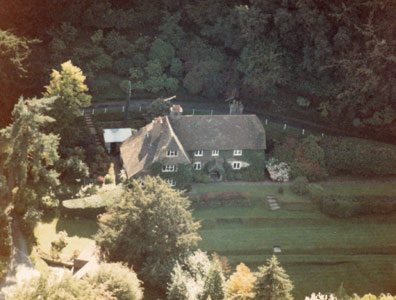

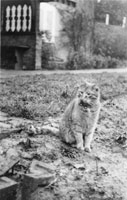
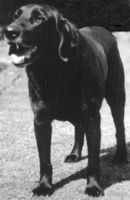
My father had a bad stammer. At home he liked to go upstairs and write. He was a quiet and affectionate Father. He did not put himself about. I think that perhaps he didn't mind stammering; it afforded shelter from the world.
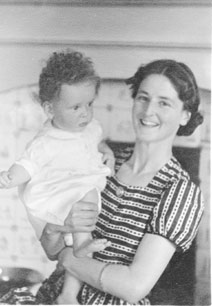
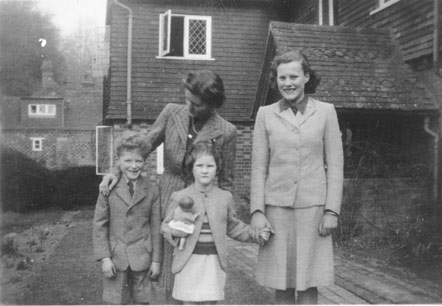
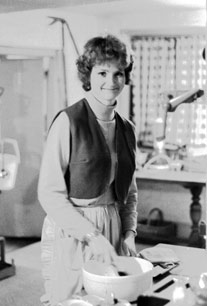
My earliest memory is of sitting by an open window in the summertime being rubbed down after a bath. We enjoyed a glorious childhood. From early years I just remember love and warm sunshine. The second photo above shows me, Polly and Bridget in ~1945, backed by our mother, and the third shows my sister Polly baking at Christmas 1970. The photo below shows my mother attending a wedding in ~1958. She always looked cool.
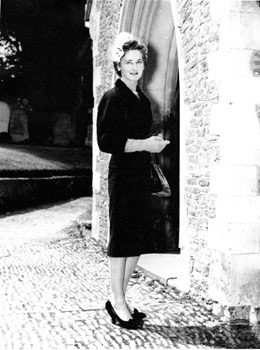
At the age of 9 Polly contracted diabetes mellitus and thereafter had to receive injections of insulin, a great handicap. I used to wet the bed, and was sent off to Radley College at the age of 13 still suffering from this affliction. In his classic 1936 book “How to Win Friends and Influence People”, Dale Carnegie wrote (on page 48-9 of the Vermilion edition) that my parents should have found a way to make me want to stop the bed-wetting; but they were too kind. My Social Tutor at Radley didn't like his small and immature pupil, so I was not happy. Many years later at some reunion a prominent master met me and asked “What were you good at?? Ah yes, Mathematics!” Fifty years after I was a pupil, I went back and gave a successful Powerpoint presentation to a small audience on “Some clouds” - so perhaps I may one day become persona grata in this prominent centre of British Public School excellence. I left Radley with an ingrained sense of my superiority to most of the other creatures on the planet. How can one know, understand and enjoy everything if one is obsessed with being the best? With Anima Sana In Corpore Sano running shoes, or Nike "Be as good as you can be" within reason, and don't worry.
My first big adventure was a voyage around the Mediterranean in the Cunard ship "Lycia", ~3500 tons, out of Liverpool on 30 July 1958 bound for Swansea. This was arranged by my uncle Ralph Jackson, who was a printer with Thos. Foreman & Sons. We carried a mixed cargo of miscellaneous goods ranging from turbine blades and tyres to whisky and ice cream. The crew consisted of the Captain, Chief Officer, 2nd and 3rd Officers, Chief Engineer, Radio Officer, Apprentice, four Engineer Officers, Chief Steward and others to a total of 36. I occupied the Pilot's cabin. I used to study Electricity and Magnetism, read more generally, chat mostly with the Radio Officer Sparks, and play draughts and a little chess with some of the others. I soon got used to the rolling motion of the ship, and enjoyed the happy atmosphere on board.
I was shown the Rowan Doxford diesel engine which developed 3500 horsepower at 14.5 knots. Steam was used to power electrical generators, the ship's steering, winches, pumps and the sea water cooling system.
At 0300 on 4 August we were off Cape Finisterre and saw its lighthouse beams. Nights were getting warmer. We reached Casablanca at about 1800 on 5 August, larger than I expected, built up by the French. The Arab dockers had no sense of urgency; they took a lunch break of over 2 hours. Two days later I had time for a tour by taxi around the imposing Rock of Gibraltar with its frisky population of Barbary macaque monkeys.
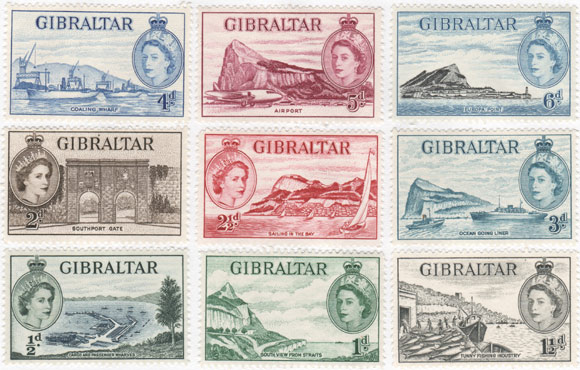
We reached Genoa at 0600 on 10 August. I spent time there with Sparks. A sober and reserved man, he enjoyed my gentlemanly company. We attended a service at San Lorenzo Cathedral; people constantly came and went informally. Next day we took a bus for a half hour ride along the hilly Italian Riviera to the luxurious resort Portofino, peppered with little houses and churches in pastel shades of red, yellow and brown, the hills sometimes cut into four-foot steps.
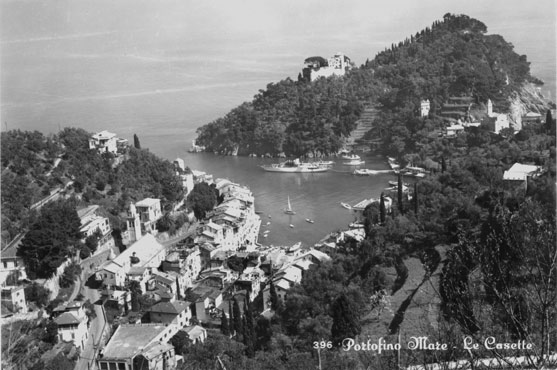
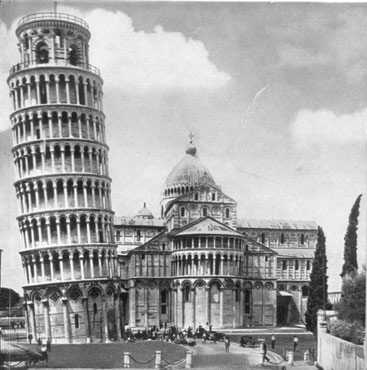
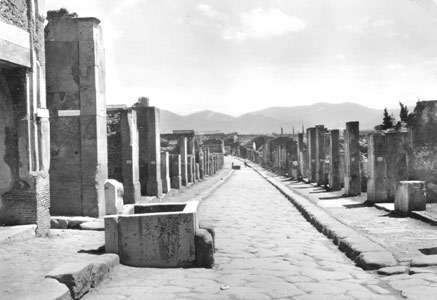
Up at the top of Mount Vesuvius, the crater was roughly 200 m deep and 250 m across. Smoke and steam issued from fissures in the rock and gave rise to green slime. Apart from yellow sulphur near the lip and white magnezium it looked rather ordinary. I got a ride back into Naples with a cheery American and his family.
We arrived in Salerno at 0800 on 19 August. I went for a swim and in the afternoon visited the Cathedral at Amalfi, rather thicker inside than others in Genoa and Naples. The dockers spilled three boxes of canned tomatos over the key as they were loading. We left at 2100 and anchored off Sousse at 2200 on 20 August. Smaller than most of the ports we visited, Sousse was made of yellow stone mostly, with a large town hall type lighthouse in the middle and evergreen trees and sand on either side. While waiting at anchor through 21 August, we sunbathed, played water polo, swam round the ship and played many games of draughts. Into Sousse at 0600 on Saturday 23 August, we lay fallow all day because of an Arab holiday. We went ashore and mingled guardedly with the Arabs. It was good to get to sea again two days later.
We anchored off Hiraklion, Crete, at 2015 on 27 August. The water of the harbour was most beautiful, with different patches of dark green, turquoise blue, sky blue and navy blue colours. The Minoan settlement of Knossos had beautiful wall paintings. Hiraklion was full of foreign manufactured goods (razor blades and Dinky toys). Most business was conducted in the narrow streets, with few motors. The people were cheerful, but they tied up live hens by their legs in the market. I enjoyed befriending girls in the Bank of Crete.
Messina in Sicily, visited on 31 August, was notable for a twin-hulled hydrofoil ferry of speed ~20 knots. We arrived at Catania at 2100. I saw the blue-domed Cristoforo Colombo church, built in stone with marble altars and floors. Next day we proceeded through the Straits of Messina and on to Ceuta, where we arrived at 2000 on 4 September. A modern Spanish outpost in Morocco across the Mediterranean, it was not unlike Gibraltar in its single high street, pleasantly vegetated rocky peninsula and atmosphere of happy business. I walked for two hours to the lighthouse, pursued rather unnervingly in the darkness by a light house keeper. Eventually I exchanged amiable pleasantries with this young man, not understanding what he was saying. I forgot to try to persuade him to show me his lighthouse. We left at 0630 next morning.
Always very kind and forthcoming, the Officers taught me to steer the ship, and presented me with a Steering Certificate.
Through the Pillars of Hercules, past the beautiful Cabo da Roca and across the Bay of Biscay with a 6° roll, we anchored in the Mersey at 2330 on 8 September. After visiting Cunard's Mediterranean & Freight Department at 1000 the next morning, I visited the Cathedral, sombre red stone, and then left Liverpool from Lime Street Station for Haslemere.